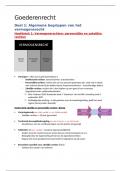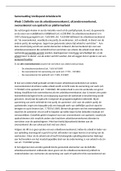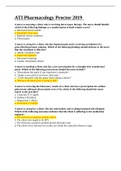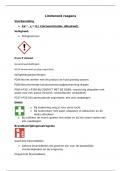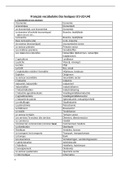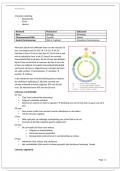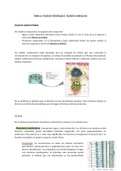Lecture 2: The EU commission:
→ Why look at institutions (not all about member states?)
1. Neorealist view (state-centric approach)
- IR view
- downplays the role of institutions
- ‘ False promise of IO’s
- Focus on what nations do
- Rescue of the nation-state ( Mearsheimer)
→ ‘EU is another way to ensure that member state is at
forefront of all actions’
2. Institutional approach ( Argues that institutions matter)
→ why look at institutions?
- Also, have an impact on how states see their preferences
- Altering state preferences
- Altering power structure
- providing normative environments
→ Treaty 13
- Stipulates what the commission is all about
- ‘ The union shall have an institutional framework
Aim to promote its values it’s advance its objectives serve its interests those
of its citizens and those of the member state + continuity and efficiency
→ The EU institutions:
1. EU parliament
2. EU council
3. The council
4. The commission
5. Court of justice
6. Court of auditors
-
1
,⇒ Controlling bodies: Court of justice + Court of auditors
⇒ Financial bodies: Central bank
→ The commission purpose/ function :
‘ The commission shall ‘promote general EU interest’
1. Guardian of treaties and legal framework
- The task of monitoring the application of EU primary and secondary laws
ensuring its uniform application throughout the EU
- Gather information to monitor EU countries compliance
- Association with Eu courts and commission
- firms breaking EU laws
- Oversees member states
⇒ What happens when EU countries don’t comply?
⇒ Formal procedure:
→ The commission may send it a letter of ‘formal notice’ allows Eu
country to submit its observation
→ If the commission is still of the opinion that the violation of the EU
rules persist
→ sends reasoned opinion to the EU country
-
2
, → If opinion remains without effect
→ The commission may bring the case before the court of EU ( 258)
( decisions legally binding)
⇒ Second court procedure:
- The court may impose a financial penalty
⇒ First judgment:
- Impose financial sanctions ( already when passing first judgments)
⇒ Any individual or entity may also lodge a complaint with the commission if a
measure / administrative practice in an EU country appears to violate EU rules.
→ However, only the Commission that may initiate the procedure
under Articles 258 and 260 TFEU ( so bring the case in front of the court)
⇒ Causes of infringements (noncompliance)
1. Late or non transposition
2. Wrong application of treaties
● Commissioners gives higher priorities to theses (preferences)
⇒ Softer way of monitoring:
1. Informal meetings
2. Guidance
3. communication
4. social pressure (naming and sharing)
→ Who is afraid of commissions
= Firms
⇒ Laws actions against firms:
( Number of rules to ensure fair play)
⇒ Managing front line policy implementation
supervisor and overseer of EU policies
1. Breaching(making breakthrough) EU law on restrictive practices and abuse of
dominant market positions
Eg: EU imposed fines on google → Fines on using monopoly to
dominate the market
2. Breaching EU law on state aid
Eg: Republic or Ireland gave illagal tax benefits to Applle → Ireland
fined
3. Breaching EU law on company mergers
-
3
, - Merge decision: If more than one company wants to become one new
‘merged company’
→ EU rule cant abuse market positions
⇒ EU has prohibited Siemens and Alstom merge
→ The merger would have harmed competition in markets ( for
railways and high speed)
2. Rights of initiative (can propose a law) & EU legal instruments:
- Commission has a right of initiative when it comes to most of the EU law
- The commission comes with a proposal → goes through the law-making
procedure → Council and the EP have to approve
- given rule power making
- grey area: policy overlaps with administration
- exercising rulemaking power not to be independent of the council
⇒ EU legal instruments:
= Secondary laws
REGULATIONS: directly and immediately binding in their entirety (often rules of
procedure or technical standards)
- don’t have to be changed into national law
- process of regulating rules
- Eg: EU regulations on fishing
DIRECTIVES: binding in terms of goals, but the states may decide how to achieve
those goals
(often future objectives or harmonization (the process of creating common standards
across the internal market )
- Has to be changed into national law
- official instructions
- Eg: Working time
DECISIONS: binding but targeted at specific member states, individuals or
institutions
RECOMMENDATIONS: not binding
OPINIONS: not binding
-
4
→ Why look at institutions (not all about member states?)
1. Neorealist view (state-centric approach)
- IR view
- downplays the role of institutions
- ‘ False promise of IO’s
- Focus on what nations do
- Rescue of the nation-state ( Mearsheimer)
→ ‘EU is another way to ensure that member state is at
forefront of all actions’
2. Institutional approach ( Argues that institutions matter)
→ why look at institutions?
- Also, have an impact on how states see their preferences
- Altering state preferences
- Altering power structure
- providing normative environments
→ Treaty 13
- Stipulates what the commission is all about
- ‘ The union shall have an institutional framework
Aim to promote its values it’s advance its objectives serve its interests those
of its citizens and those of the member state + continuity and efficiency
→ The EU institutions:
1. EU parliament
2. EU council
3. The council
4. The commission
5. Court of justice
6. Court of auditors
-
1
,⇒ Controlling bodies: Court of justice + Court of auditors
⇒ Financial bodies: Central bank
→ The commission purpose/ function :
‘ The commission shall ‘promote general EU interest’
1. Guardian of treaties and legal framework
- The task of monitoring the application of EU primary and secondary laws
ensuring its uniform application throughout the EU
- Gather information to monitor EU countries compliance
- Association with Eu courts and commission
- firms breaking EU laws
- Oversees member states
⇒ What happens when EU countries don’t comply?
⇒ Formal procedure:
→ The commission may send it a letter of ‘formal notice’ allows Eu
country to submit its observation
→ If the commission is still of the opinion that the violation of the EU
rules persist
→ sends reasoned opinion to the EU country
-
2
, → If opinion remains without effect
→ The commission may bring the case before the court of EU ( 258)
( decisions legally binding)
⇒ Second court procedure:
- The court may impose a financial penalty
⇒ First judgment:
- Impose financial sanctions ( already when passing first judgments)
⇒ Any individual or entity may also lodge a complaint with the commission if a
measure / administrative practice in an EU country appears to violate EU rules.
→ However, only the Commission that may initiate the procedure
under Articles 258 and 260 TFEU ( so bring the case in front of the court)
⇒ Causes of infringements (noncompliance)
1. Late or non transposition
2. Wrong application of treaties
● Commissioners gives higher priorities to theses (preferences)
⇒ Softer way of monitoring:
1. Informal meetings
2. Guidance
3. communication
4. social pressure (naming and sharing)
→ Who is afraid of commissions
= Firms
⇒ Laws actions against firms:
( Number of rules to ensure fair play)
⇒ Managing front line policy implementation
supervisor and overseer of EU policies
1. Breaching(making breakthrough) EU law on restrictive practices and abuse of
dominant market positions
Eg: EU imposed fines on google → Fines on using monopoly to
dominate the market
2. Breaching EU law on state aid
Eg: Republic or Ireland gave illagal tax benefits to Applle → Ireland
fined
3. Breaching EU law on company mergers
-
3
, - Merge decision: If more than one company wants to become one new
‘merged company’
→ EU rule cant abuse market positions
⇒ EU has prohibited Siemens and Alstom merge
→ The merger would have harmed competition in markets ( for
railways and high speed)
2. Rights of initiative (can propose a law) & EU legal instruments:
- Commission has a right of initiative when it comes to most of the EU law
- The commission comes with a proposal → goes through the law-making
procedure → Council and the EP have to approve
- given rule power making
- grey area: policy overlaps with administration
- exercising rulemaking power not to be independent of the council
⇒ EU legal instruments:
= Secondary laws
REGULATIONS: directly and immediately binding in their entirety (often rules of
procedure or technical standards)
- don’t have to be changed into national law
- process of regulating rules
- Eg: EU regulations on fishing
DIRECTIVES: binding in terms of goals, but the states may decide how to achieve
those goals
(often future objectives or harmonization (the process of creating common standards
across the internal market )
- Has to be changed into national law
- official instructions
- Eg: Working time
DECISIONS: binding but targeted at specific member states, individuals or
institutions
RECOMMENDATIONS: not binding
OPINIONS: not binding
-
4


